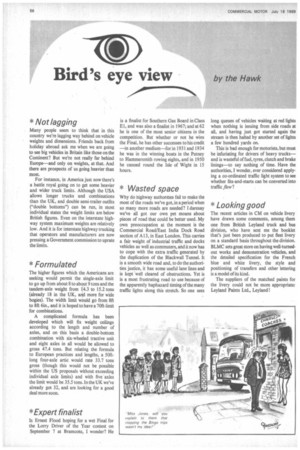Bird's eye view •
Page 58

If you've noticed an error in this article please click here to report it so we can fix it.
by the Hawk * Not lagging
Many people seem to think that in this country we're lagging way behind on vehicle weights and dimensions. Friends back from holiday abroad ask me when we are going to see big vehicles in Britain like those on the Continent? But we're not really far behind Europe—and only on weights, at that. And there are prospects of us going heavier than most.
For instance, in America just now there's a battle royal going on to get some heavier and wider truck limits. Although the USA allows longer trucks and combinations than the UK, and double semi-trailer outfits ("double bottoms") can be run, in most individual states the weight limits are below British figures. Even on the interstate highway system maximum weights are relatively low. And it is for interstate highway trucking that operators and manufacturers are now pressing a Government commission to uprate the limits.
* Formulated
The higher figures which the Americans are seeking would permit the single-axle limit to go up from about 8 to about 9 tons and the tandem-axle weight from 14.3 to 15.2 tons (already 18 in the UK, and more for wide bogies). The width limit would go from 8ft to 8ft 6in., and it is hoped to have a 70ft-limit for combinations.
A complicated formula has been developed which will fix weight ceilings according to the length and number of axles, and on this basis a double-bottom combination with six-wheeled tractive unit and eight axles in all would be allowed to gross 47.4 tons. But relating the formula to European practices and lengths, a 50ftlong four-axle artic would rate 33.7 tons gross (though this would not be possible within the US proposals without exceeding individual axle limits) and with five axles the limit would be 35.5 tons. In the UK we've already got 32, and are looking for a good deal more soon.
*Expert finalist
Is Ernest Flood hoping for a wet Final for the Lorry Driver of the Year contest on September 7 at Bramcote, I wonder? He is a finalist for Southern Gas Board in Class El, and was also a finalist in 1967; and at 62 he is one of the most senior citizens in the competition. But whether or not he wins the Final, he has other successes to his credit —in another medium—for in 1931 and 1934 he was in the winning boats in the Putney to Hammersmith rowing eights, and in 1950 he canoed round the Isle of Wight in 15 hours.
* Wasted space
Why do highway authorities fail to make the most of the roads we've got, in a period when so many more roads are needed? I daresay we've all got our own pet moans about pieces of road that could be better used. My own preoccupation at the moment is the Commercial Road/East India Dock Road section of A13, in East London. This carries a fair weight of industrial traffic and docks vehicles as well as commuters, and it now has to cope with the extra traffic generated by the duplication of the Blackwall Tunnel. It is a smooth wide road and, to do the authorities justice, it has some useful lane lines and is kept well cleared of obstructions. Yet is is a most frustrating road to use because of the apparently haphazard timing of the many traffic lights along this stretch. So one sees long queues of vehicles waiting at red lights when nothing is issuing from side roads at all, and having just got started again the stream is then halted by another set of lights a few hundred yards on.
This is bad enough for motorists, but must be infuriating for drivers of heavy trucks— and is wasteful of fuel, tyres, clutch and brake linings—to say nothing of time. Have the authorities, I wonder, ever considered applying a co-ordinated traffic light system to see whether fits-and-starts can be converted into traffic flow?
* Looking good
The recent articles in CM on vehicle livery have drawn some comments, among them one from British Leyland truck and bus division, who have sent me the booklet that's just been produced to put fleet livery on a standard basis throughout the division. BLMC sets great store on having well-turnedout works and demonstration vehicles, and the detailed specification for the French blue and white livery, the style and positioning of transfers and other lettering is a model of its kind.
The suppliers of the matched paints for the livery could not be more appropriate: Leyland Paints Ltd., Leyland!
















































































































